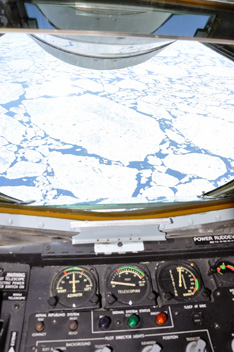Saving Gas Over the Top
An Air Force KC-135 Stratotanker’s mission over the North Pole reveals the potential for saving $54,000 and 4.5 hours of flight time
/https://tf-cmsv2-smithsonianmag-media.s3.amazonaws.com/filer/e9/f4/e9f472dc-530e-479f-81e3-d8128078b5fb/boeing_kc-135_stratotanker.jpg)
An Air Force KC-135 Stratotanker may haul more than 31,000 gallons to refuel other aircraft, but for long-haul missions, it needs to watch every drop of its own fuel. That’s why, when a KC-135 crew flew from Washington state to Kyrgyzstan over the North Pole last month, the Air Force brass was pumped.
It wasn’t because they were overflying the airspace of their former Cold War enemy. The Air Force hardly mentioned the military significance of these new routes over Russia and Kazakhstan when they opened in November. The focus instead was on all the money that would be saved.

A view from the KC-135 Stratotanker as it crossed the Arctic on June 22. Photo: USAF/Capt. Kathleen Ferrero
The Pentagon called the June 21 mission “historic” because its shorter route saved $54,000 and 4.5 hours of flight time compared with previous flights over England, which also required a day of crew rest in each direction. Fleet-wide savings to the fuel tab may run $133 million per year.
Two weeks before the KC-135 flight, a C-5M Galaxy crossed the Pole as it flew from Dover, Delaware, to Bagram Airfield in Afghanistan. The new agreements allow up to 4,500 flights yearly over Russian and Kazakh airspace, including the delivery of munitions and other lethal supplies.
Civilian airlines have been crossing the Pole since 1998 with a choice of four routes. Now the polar routes will shorten the time and bill connecting continental U.S. airbases to the front lines in Afghanistan. Air Force aircraft based in Ramstein, Germany, still need to detour around Iran.
For decades, defending against the threat of either country sending a military aircraft “over the top” was costly and all-consuming. Vast lines of early warning and defensive equipment flanked U.S. and Soviet borders. Today the budgetary threat is just as important, since the Air Force burns more fuel than any other branch of the Department of Defense. Air Mobility Command, which operates the tankers, absorbs 60 percent of that bill.
